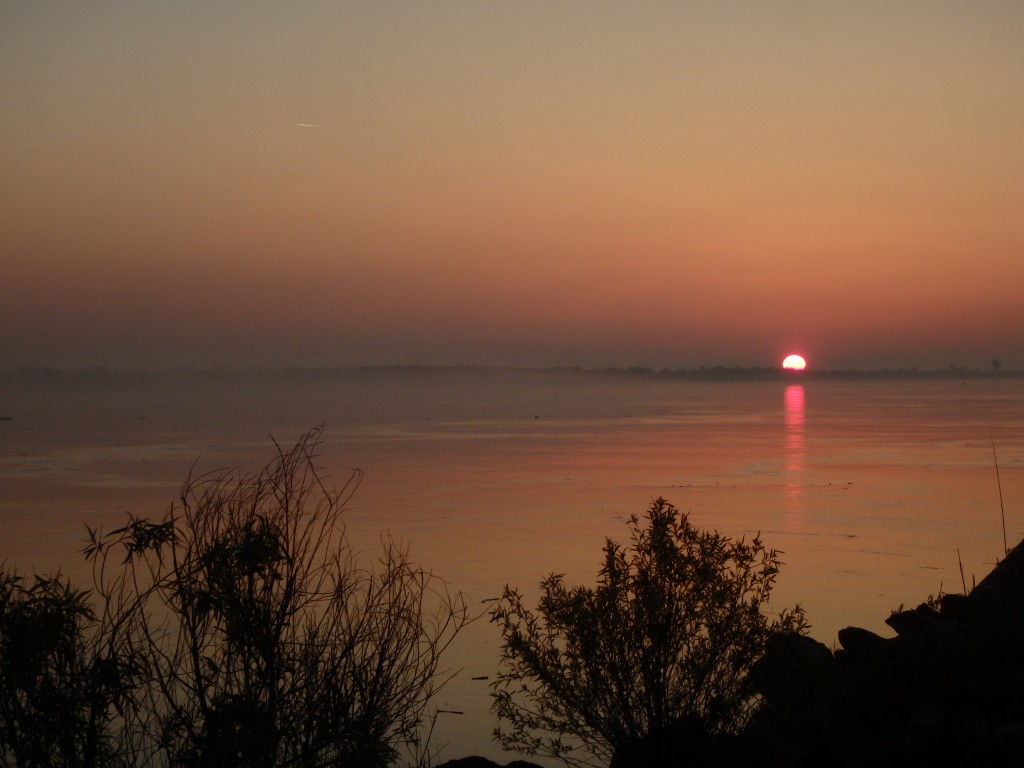 Unfortunately the next morning I lingered a bit in watching the sunrise – it was one of the most spectacular I had seen, beginning almost clear and then rising into a layer of cloud or smog, and turning red and strange. It was precisely the kind of sunrise you would expect in a town called “Port Sulphur.” The cause of the strange redness I do not know, but it is certainly a fact that the lower stretch of the Mississippi from Baton Rouge south is home to a substantial segment of America’s chemical plants and refineries. It is known as “Cancer Alley” for the effects living here seems to have on local residents. But however terrible these sunrises may be, I may also report that they are beautiful: I just stared and stared and amazed into it for quite awhile. The reason this is significant is that when the colors of the sunrise had faded I was still packing away my tent when a pickup truck came over the levee and pulled to a halt nearby.
Unfortunately the next morning I lingered a bit in watching the sunrise – it was one of the most spectacular I had seen, beginning almost clear and then rising into a layer of cloud or smog, and turning red and strange. It was precisely the kind of sunrise you would expect in a town called “Port Sulphur.” The cause of the strange redness I do not know, but it is certainly a fact that the lower stretch of the Mississippi from Baton Rouge south is home to a substantial segment of America’s chemical plants and refineries. It is known as “Cancer Alley” for the effects living here seems to have on local residents. But however terrible these sunrises may be, I may also report that they are beautiful: I just stared and stared and amazed into it for quite awhile. The reason this is significant is that when the colors of the sunrise had faded I was still packing away my tent when a pickup truck came over the levee and pulled to a halt nearby.
I had known the area where I had camped, some flat ground by an old landing between the river and the levee, was not truly abandoned or waste ground: I had seen vehicle tracks. But it had been a convenient place to stop for the night. There is a good deal of good camping between the levee and the river: since it floods, no houses are built there, but there is often quite a bit of ground which is flat and (this not being a bad flood year) dry. The only problem is that the rich, fertile soil will typically support a tangled thicket of vegetation, except where human beings have kept the ground clear. And in order to do this, they must be using the ground a fair amount. And so you are likely to be discovered in your campsite. The best plan is to leave before sunrise.
But I hadn’t left before sunrise, and now I had a serious-looking visitor. He got out of his truck and walked right toward me, with his head down. A lack of direct engagement is a pretty sure indicator that the conversation will not be between person and person, but between violator of rules and enforcer of rules.
“Uh-oh, am I in trouble?” It was my standard opening gambit.
“Straight to jail,” he replied.
“Straight to jail!”
“Straight to jail,” he repeated, looking up at me. He was an older man with a gray moustache and a baseball cap. His face was hard and did not change when it met my gaze. I did not get any particular impression from him that he would give a damn about calling the cops on me.
“I’m sorry. I’ll be out of here in a minute. I was biking along the levee yesterday, and I thought that the levee was public property. I’m biking up the Mississippi River, and last night was my first night, so I wanted to be right by the river.”
“This is private property.”
“I see you’re doing work here. These look like bulldozer tracks.”
“I’m building a gravel dump.”
“You know I was talking with some guys yesterday about how they used gravel for the oyster business. Will you be doing any of that?”
“Well,” he said, warming slightly now that the topic of his business had come up, “I’ll be selling mostly for building purposes, driveways, that kind of thing.”
“I would imagine with the subsidence and water around here, there would be quite a need for shoring up driveways.” Just now another pickup truck came over the levee. I was a bit afraid it would be a cop, but the truck was a bit beat up and it was driven by a plainclothes black man.
He watched the truck come to a stop, then looked at me. “So you’re biking up the Mississippi, huh?”
“From the Gulf to Minnesota.”
“You haven’t gotten very far.”
“Well, just the first day. And I took it easy.”
“Well, I’m going to get to work. Watch your step.”
“Will do. Thank you.” He had been mollified, it seemed. I was not going to get arrested that morning. He went off to speak with the black man, who it appears was his partner or employee.
I packed up quickly and off I went. Within a few minutes I was in Port Sulphur. I stopped off at the Catholic Church there, and, finding the door open, went in. It was a nice enough church; I always appreciate that Catholics offer these spaces to the public, for people to use – just to sit in, or be alone in, or be quiet in. This one had some windows which I found nice, and finding my back very stiff from a night on the ground, I prayed for health enough to finish the trip. I also prayed for love, to have and to give.
Port Sulphur was the site of a large sulfur industry; the swamps nearby contain underground some of the world’s largest deposits of the mineral, which was brought through the swamps to the river here, where it was processed and sold. Sulfur is a basic component of many industrial chemicals, as well as being used as an acidifying fertilizer on alkaline soils. Most of the world’s demand today, however, is met by sulfur extracted from petroleum during the refinement process, a nice example of industrial thrift: desulfurized fossil fuels emit far less sulfur dioxide into the air, which is not only a pollutant in itself, but becomes sulfuric acid in the atmosphere, a major component of acid rain. And by purifying our gasoline of this brimstone, we get sulfur for our industrial purposes.
But in the process the need for sulfur mines was greatly diminished, and the mine is now closed. The old buildings have now become the de facto seat of Plaquemines Parish, whose courthouse and offices burnt down some years ago (and then Hurricane Katrina came, which gave the Parish government other things to do besides restore their own buildings). But Port Sulphur still lives on as a town, and in fact it had a supermarket, the first I had seen coming up the river. I stopped to “make groceries,” as they say, and I enjoyed the atmosphere there: it seemed everyone knew everyone, white and black both.
North of Port Sulphur all the northbound roads are gathered into the highway, which passes through a swamp; the larger, older trees on the western side of the road were almost all dead, from the sea’s irrumation of the wetlands during Hurricane Katrina. I turned off the highway at West Pointe a la Hache, where a quiet country road brought me over the levee and down to a metal structure on the river; it looked like a canal lock, but with a drawbridge rather than doors. There were no people there; just a port-a-potty and a large garbage pail which had fallen on its side. This was the Pointe a la Hache ferry. Coming to it, though, I feared that like many ferries it had been shut down: there were no cars there, no signs, no schedules: the ferry, it appeared, was closed.
This was a disappointment. As I approached each potential river-crossing I considered which side of the river I preferred to follow, and I had determined that I would like to cross to the eastbank here. New Orleans was on the eastbank, so I was going to cross sometime before New Orleans; the bridges at New Orleans were dangerous – extremely dangerous, as I recalled – for bicycle traffic, so I was hoping to cross by a ferry. I was confident the Algiers Ferry would still be running, but there were two others, at Pointe a la Hache and Belle Chaisse. I wanted to get a chance to get on the river, and see Pointe a la Hache besides: like Venice, it was at the end of a road, this time the end of the eastbank road, and I wanted to see if the eastbank was different.
As I was contemplating this a car came up behind me and pulled to a stop, cutting its ignition. The driver was not looking for me: he was expecting the ferry. Looking to the other side of the river, I could see that there was a boat moored on the other side; and indeed, as I watched, it darted out from its dock and came into the middle of the river, facing the current, its course sagging downstream like a clothesline full of wet clothes. But this was no gradual process, like watching the Staten Island Ferry lumber across New York Harbor: this boat had powerful little engines, and its arcing course was a study in efficiency: in a few quick moments it was chugging up to the ferry-dock before me, facing upstream. Two more cars had appeared behind me, and the gangplank was lowered and I walked my bike on, followed by the cars. I parked my bike in a corner of the boat and took a seat on a chest of life-preservers. I was crossing the Mississippi River.
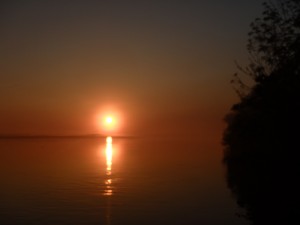
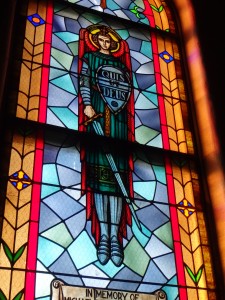
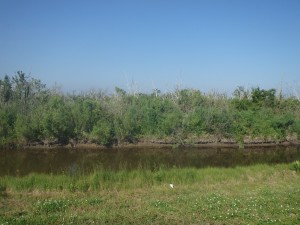
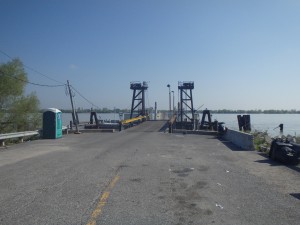
One Comment